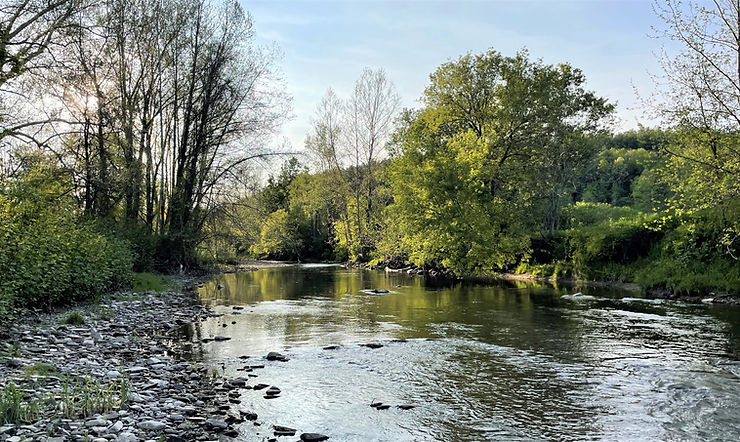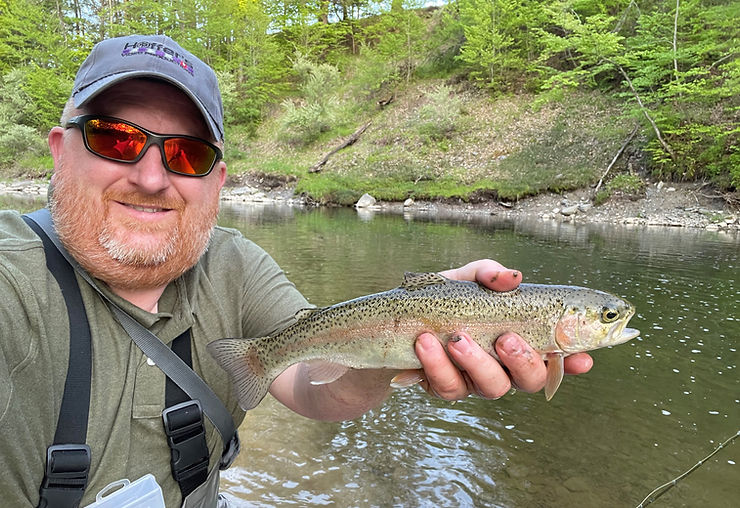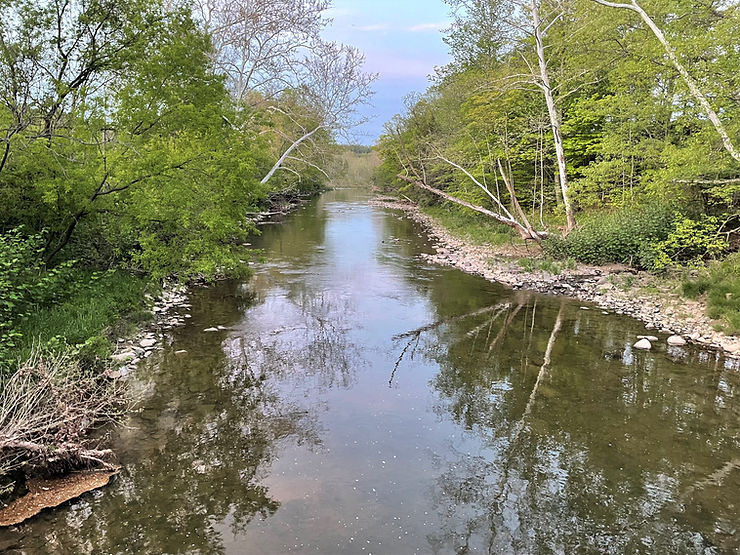Journey Through the Endless Mountains: Fishing Towanda Creek

Recently, I was in Bradford County for business and found myself with an evening to explore local waters. Bradford County is a part of Pennsylvania often referred to as the Endless Mountains, and if you’ve ever driven through here, you know why, but they’re a different kind of mountains than you might find in somewhere like Cameron County or Elk County, mainly in that Bradford County is also an area of rich agriculture. The mountains are big, but the valleys are wide and home to big farms and a good number of streams, including Towanda Creek.
About Towanda Creek
Towanda Creek is a 32.9-mile tributary of the Susquehanna River. It begins near the Lycoming and Bradford County borders, on a hill in southwestern Canton Township and flows in an east/northeast direction where it ultimately joins the Susquehanna in the town of Towanda along Pennsylvania Route 6. Near its source, the elevation is around 1,760 feet, while at the mouth, the elevation is 692 feet above sea level, so it does have a decent gradient, and in the spring or during high water events, this can make for some tricky wading.
In appearance, Towanda Creek reminds me a lot of Bowman Creek in both geological formations within the stream as well as the somewhat tannic color of the water. Its course is pocked with round, lichen-crusted boulders that can get slick when navigating the stream, especially later in the season when they start developing a little slime on them. The water color is likely a result of the many agricultural lands Towanda Creek flows through on its way to the Susquehanna.
From fall through early spring, Towanda is fairly big water downstream of West Franklin, ranging 40-60 feet wide with numerous big pools, intriguing undercuts, and mid-stream boulders. Dry weather of recent years has taken the edge off, though, and a lot of the productive pocket water has literally dried up come late May. I wish this were an exaggeration.
Towanda Creek’s name means “burial ground.” Do what you please with that piece of information!
In 2007, the Pennsylvania Fish and Boat Commission surveyed Towanda Creek. Per the biologist’s report: “Towanda Creek begins its journey as a wild trout stream. Wild brown trout were present in Towanda Creek from the headwaters downstream to West Leroy. Wild trout were relatively scarce throughout this stretch, but some large wild brown trout and holdover hatchery trout of all three species were present at most of our upstream sampling sites.”
Downstream of West Leroy, Towanda Creek is primarily a put-and-take stocked trout stream, but the middle section, which includes the delayed harvest, is referred to as transitional waters. Basically, transitional waters are those that warm up too much to support trout year round but do not contain the habitat or fertility to support a thriving warmwater fishery. However, biologists did find that this stretch of Towanda actually served as nursery waters for smallmouth bass and other warmwater species, as large numbers of yearlings were surveyed throughout this section.

Fishing Towanda Creek
Towanda Creek has a 1.7-mile Delayed Harvest Artificial Lures Only section that begins at the SR 3001 bridge and extends downstream to the bridge on Cons Road. This is a lovely section of stream that mostly flows away from the road and through some very quiet parts of the valley.
Before deciding to start fishing at the bridge on Cons Road, I drove the length of Towanda Creek just to see what it looked like in other parts. For the most part, it seemed like you could find water to fish at almost every bridge or access area where the stream came close to the road, but it was definitely very low.
At Cons Road, I followed a worn path through the woods upstream to a large pool that held a good number of trout. Farther upstream were several other nice pools stacked with fish. That’s the trouble with low water in streams like Towanda Creek. Once the pocket water dries up, all you’ve got left are a few big pools, and the water basically trickles from one pool to the next, and any trout left in the stream inevitably end up in one of those pools.
Even after discovering the huge pool upstream from the Cons Road bridge, I wasn’t expecting to get into many fish that evening. It was dry and hot, a clear blue sky with temperatures in the 80s. The pool had almost zero current. Also, the combination of late season, low and clear water, and unfavorable weather doesn’t account for many banner days.
I struggled at first, mainly because nymphing pools with such little current is very difficult. After drifting three or four different patterns through various parts of the pool, I shook the dust out of a dark corner of my fly box and came up with a size 8 black beadhead Woolly Bugger. Not expecting much, I roll cast it out about two-thirds of the way across the stream and slowly stripped it back toward me. I felt the quick bump of a hit. As soon as my second cast hit the water, though, a trout slammed it and took off downstream and next thing I knew, I was almost into my backing. It was quite a fight!
As it turned out, I’d hooked the fish in the adipose fin, probably due to the trout turning on the fly as I retrieved it. Well, regardless, his bad luck resulted in my first fish landed on Towanda Creek.
The first trout actually hooked fair and square was easily 14 inches and fought like a freight train. The next half dozen or so were also nice big rainbows with lots of spunk. All of them agreed that the black beadhead Woolly Bugger was an excellent choice.
It was an interesting evening on the stream, and it was a situation in which stripping Woolly Buggers has always been an effective tactic for me. Many fishermen only use buggers during higher water, or early spring, or in the fall. Usually, they’ll swing the bugger like a wet fly, or strip it crosscurrent. But the truth is, there is no wrong time or way to fish buggers, and they often work best when nothing else will. The key to fishing them successfully in really low water is to slow down your retrieve so that the fly is basically crawling through the pool one grueling inch at a time. It requires a lot of patience, which is not always a common commodity.
Another thing I’ve noticed about fishing Woolly Buggers in these situations is that sometimes they’re really effective for just putting trout in a feeding mode. Even if you don’t catch a fish on the bugger, its appearance and movement can shake them up a bit and get them thinking about food.
If I’m not getting hits on the ultra slow retrieve, I’ll pick up the pace and strip the fly through the pool in an attempt to trigger an impulse strike. If nothing else, I can usually get a trout or two to chase the fly. Once you have them riled up, changing back to a nymph can typically net a couple of fish. That evening, I picked up three more trout after switching back to the nymph, all within 10 minutes of running the bugger through the pool. That’s just how it is when conditions are challenging – sometimes it requires finesse and other times you have to beat them over the head to get them to eat.

Towanda Creek Hatches
Shortly before dark, a few March Browns and a fairly heavy hatch of Hendrickson spinners (a.k.a. Rusty Spinner) flitted about overhead. Occasionally I spotted the dimple of a rise, but it wasn’t nearly enough to warrant switching over to a dry fly. I waited until it was almost dark, but steady feeding never materialized. Finally, I trudged back to the truck, satisfied with the evening’s catch.
In Pennsylvania Trout Streams and Their Hatches, Charlie Meck included two paragraphs about fly fishing on Towanda Creek. The gist of it is basically that most of the locals don’t even fish this stream because it lacks good mayfly hatches and is primarily an early season, stocked fishery.
It’s said that, prior to Hurricane Agnes in June 1972, Towanda Creek had a decent Green Drake hatch. The hurricane, however, scoured the streams beds, wiping out insect and trout habitat alike, not only on Towanda Creek, but numerous other streams in this region and across the state. Towanda Creek does still have Tan Caddis, Hendricksons, March Browns, and a few others, including a Trico hatch, according to Meck’s book.
The irony of the Trico hatch is that by the time it arrives, there probably aren’t many trout left throughout much of the stream. So if you’re looking to fish that in July or August, you’re best bet would be to focus on sections of Towanda Creek above West Leroy.
Towanda Creek will probably never develop into a destination-type stream. However, a stream doesn’t have to be a well-known fishery with tons of mayflies to provide respite in the outdoors after a long day of work. All it needs is a couple of decent pools, a handful of trout, and a little solitude to make it a worthwhile stop while visiting the Endless Mountains.
Did You Enjoy What You Just Read?
Stay up to date with the Dark Skies Fly Fishing monthly newsletter for free and receive the latest posts in fly fishing news, tricks, tips, and techniques, stream reports, as well as updates on new flies added to the Online Store and exclusive discounts!
Sign Up Now

Thats’ a good point about having the wooley bugger to make the fish more active. I used always start fishing a new stream with a wooley bugger to find out where the fish were holding. On Little Mahoning, once the fish chased the bugger, a dry fly would catch him.